Tackling Climate Change with STEAM Education
P-Bit! Sensor Kits for Environmental Science (powarsteam.com)
Climate change is one of the greatest global challenges, and education plays a crucial role in preparing future generations to understand and address this issue. In this context, climate-focused STEAM education emerges as a key methodology to integrate hands-on learning with real data analysis.
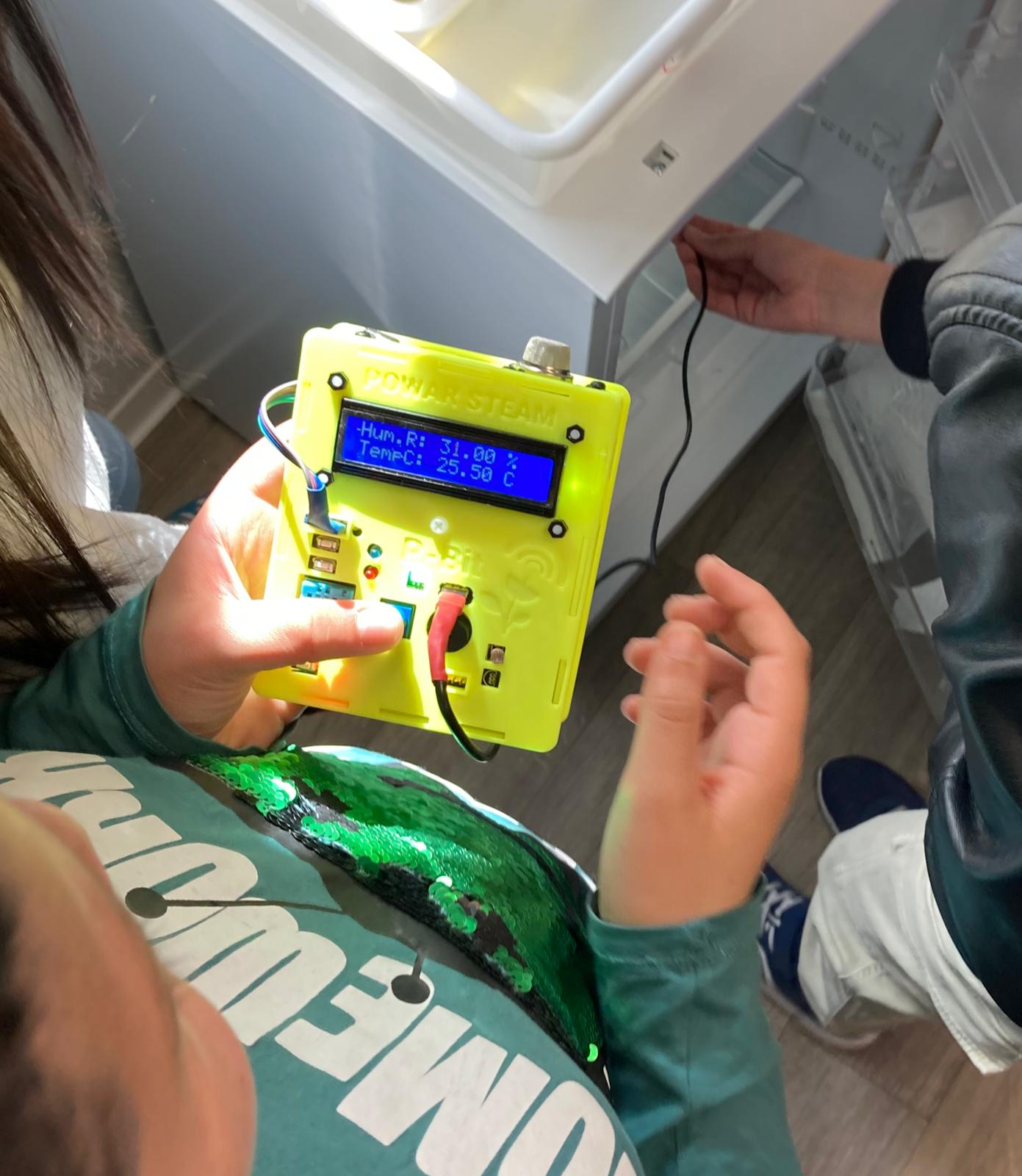
The P-Bit, an electronic device developed by POWAR STEAM, is specifically designed for this purpose. Equipped with a microcontroller, sensors for air temperature and relative humidity, air quality, sound, plant moisture, a high-temperature digital thermometer, and a light intensity sensor, the P-Bit enables students to collect and interpret environmental data. This approach fosters a deeper understanding of climate phenomena, allowing students to explore and analyze climate change in their immediate environment.

Using the P-Bit, students engage in data collection and critical interpretation, connecting learning to real-life situations and facilitating an active educational experience. This device is adaptable to any learning environment, whether in urban or rural communities, promoting climate education worldwide.
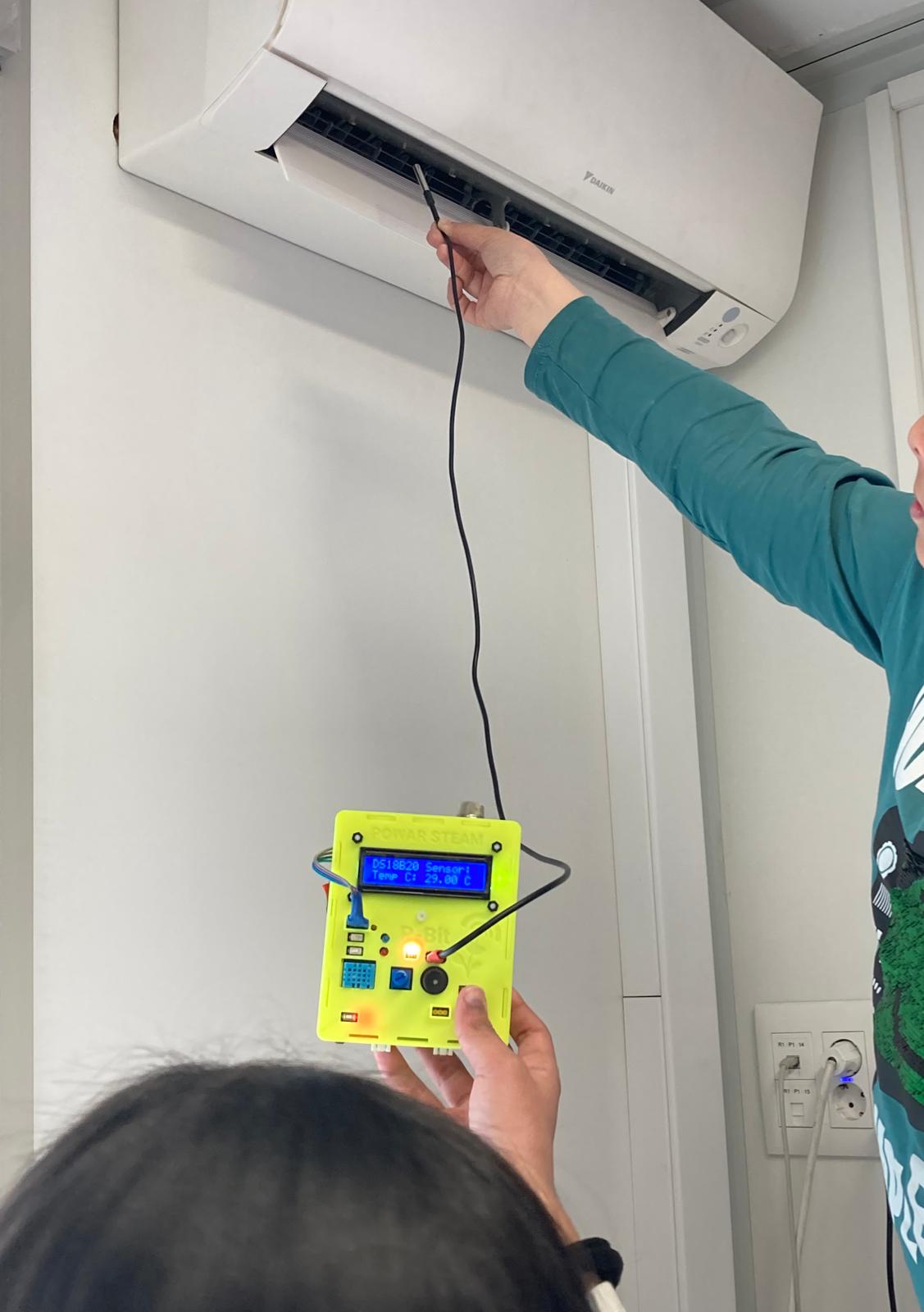
2. How the P-Bit Works in Practice
The P-Bit is designed for immediate classroom use, offering real-time data display without needing any technical setup. This device goes beyond simple data collection—it's integrated into a series of learning scenarios that we're developing in alignment with the competencies and evaluation criteria set by the LOMLOE (Spanish educational law). Additionally, these scenarios address several key GreenComp competencies from the European Union, such as systems thinking and sustainability action, ensuring that students are developing essential green skills alongside their scientific exploration.
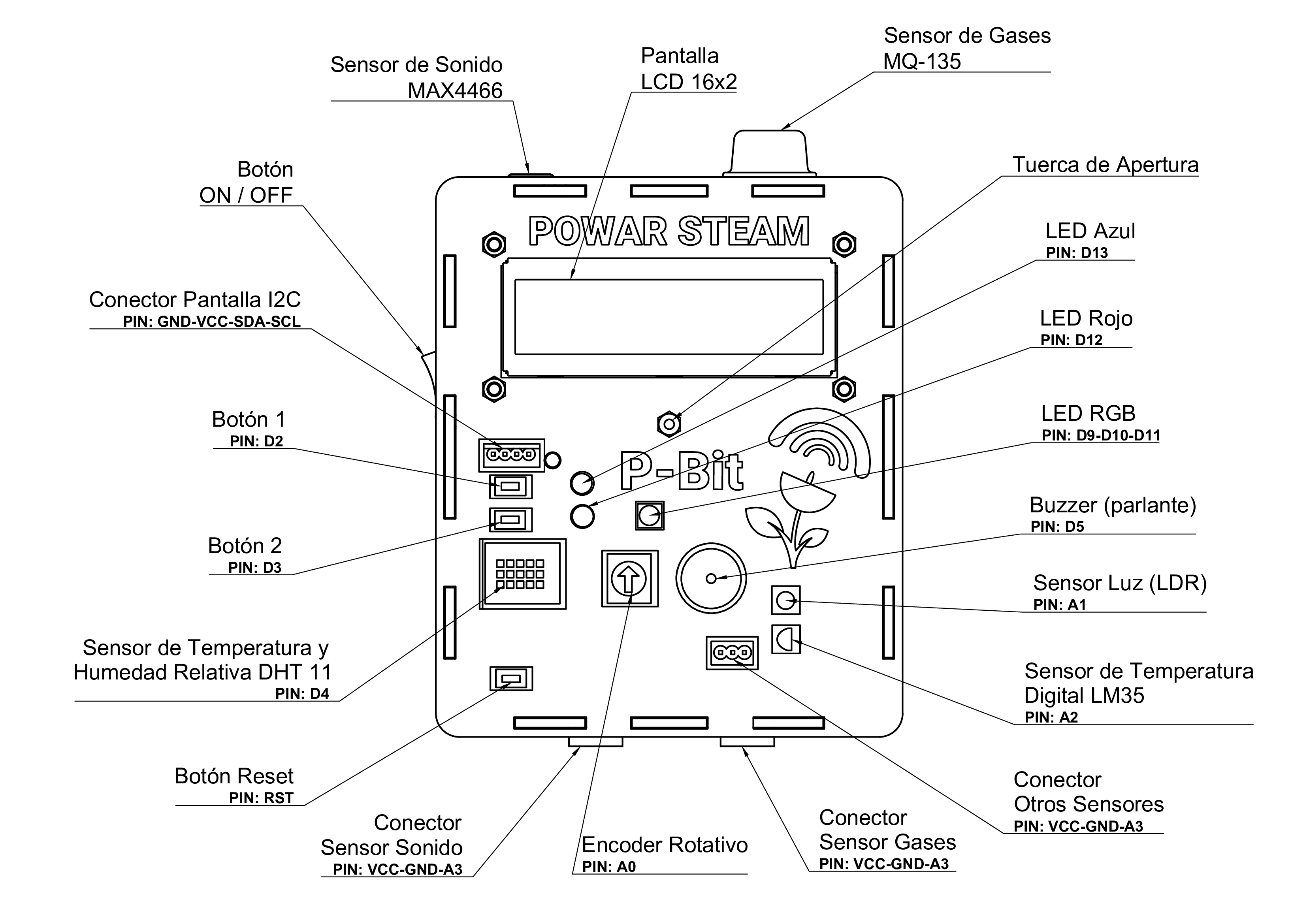
Through these curated learning scenarios, the P-Bit transforms climate education into a practical, data-driven experience, allowing students to connect classroom theory with real-world environmental data collection.
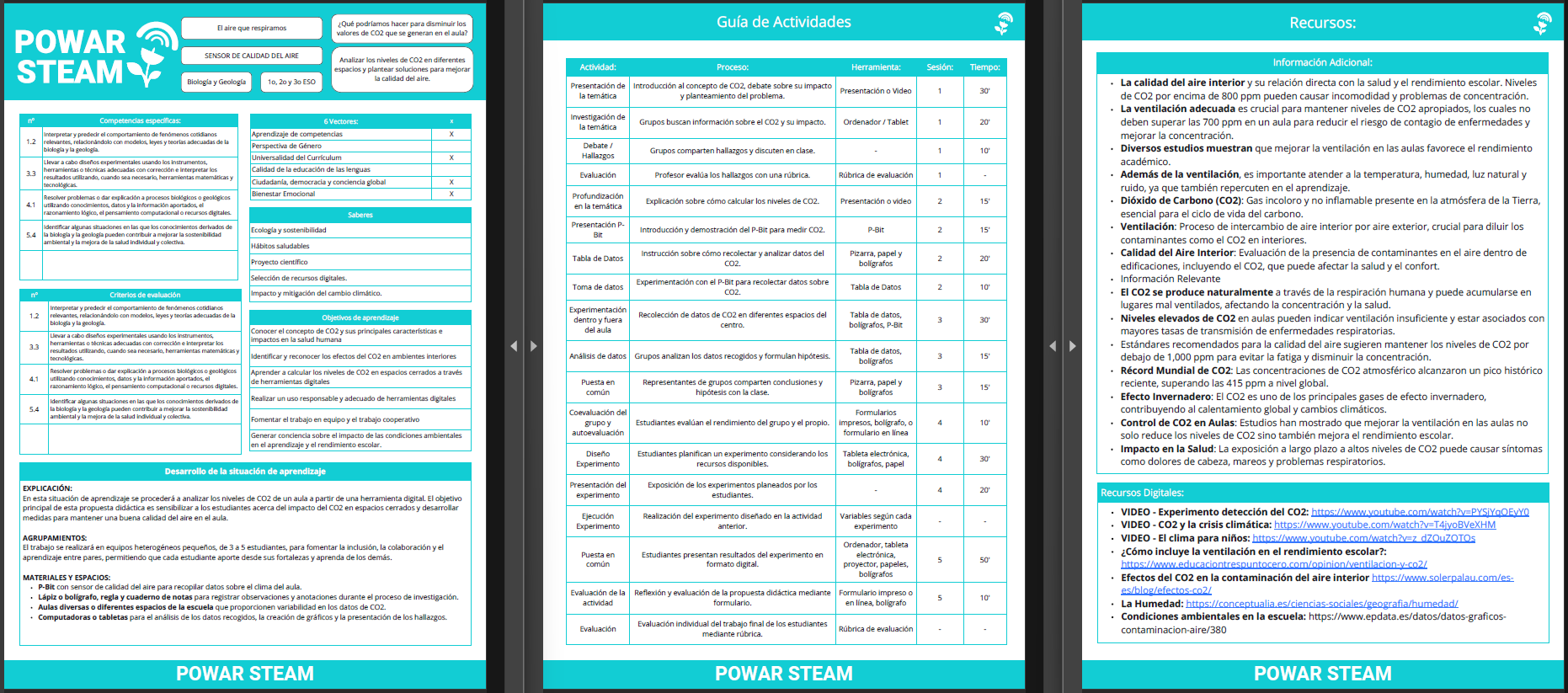
3. Learning Scenario: Climate Exploration in the school
One of the first learning scenarios we implemented with the P-Bit took place in La Florida, a densely populated, diverse neighbourhood in Hospitalet, Catalunya. This area, home to a large migrant community, provided a rich context for exploring how environmental conditions affect daily life, particularly in relation to climate change.
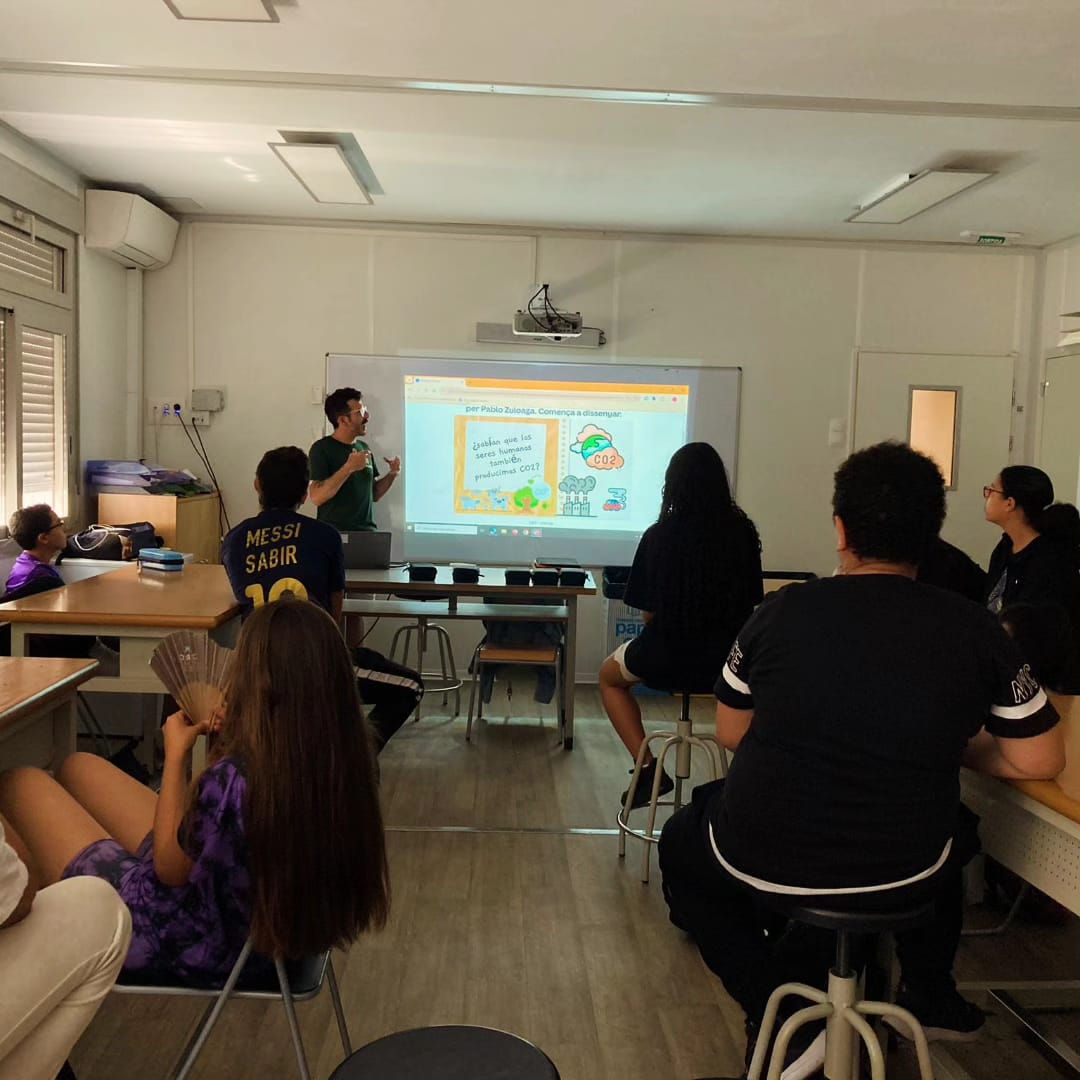
Engaging Students in Climate Conversations
We began by introducing the students to the concept of climate change, focusing on its causes and effects. Given the diverse backgrounds of the students, we encouraged them to share their personal experiences with the weather and climate of their home countries, sparking a lively discussion about how different climates impact their lives. This created a meaningful connection between global environmental issues and their personal experiences.
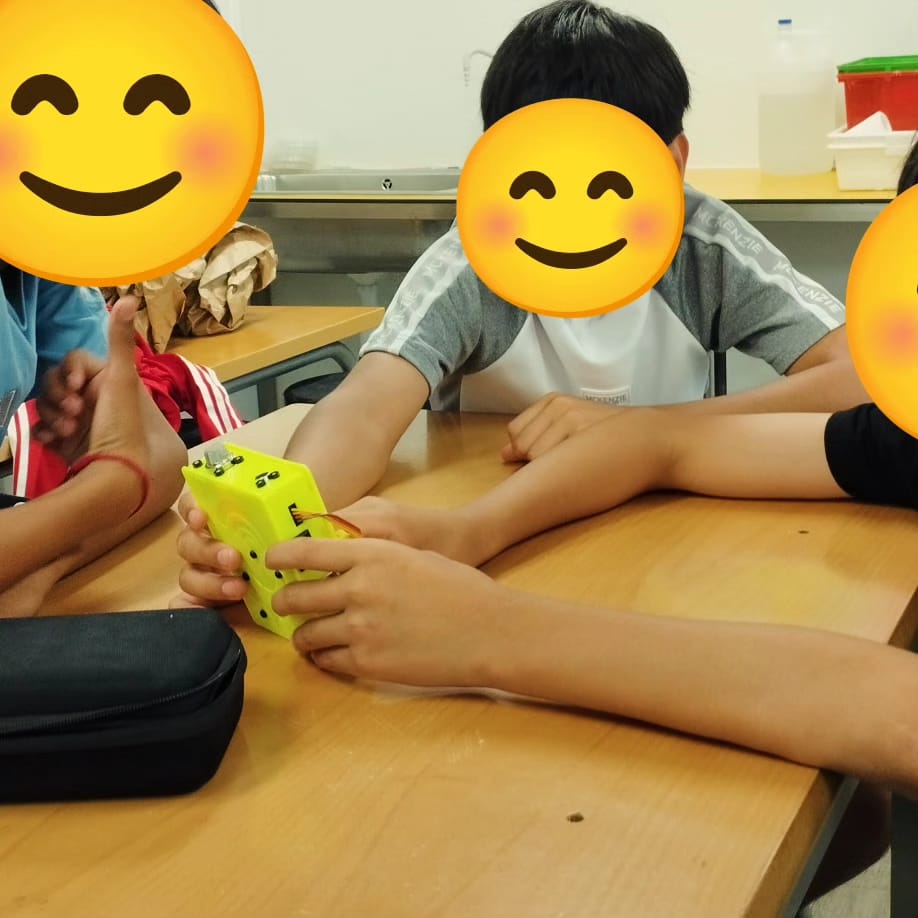
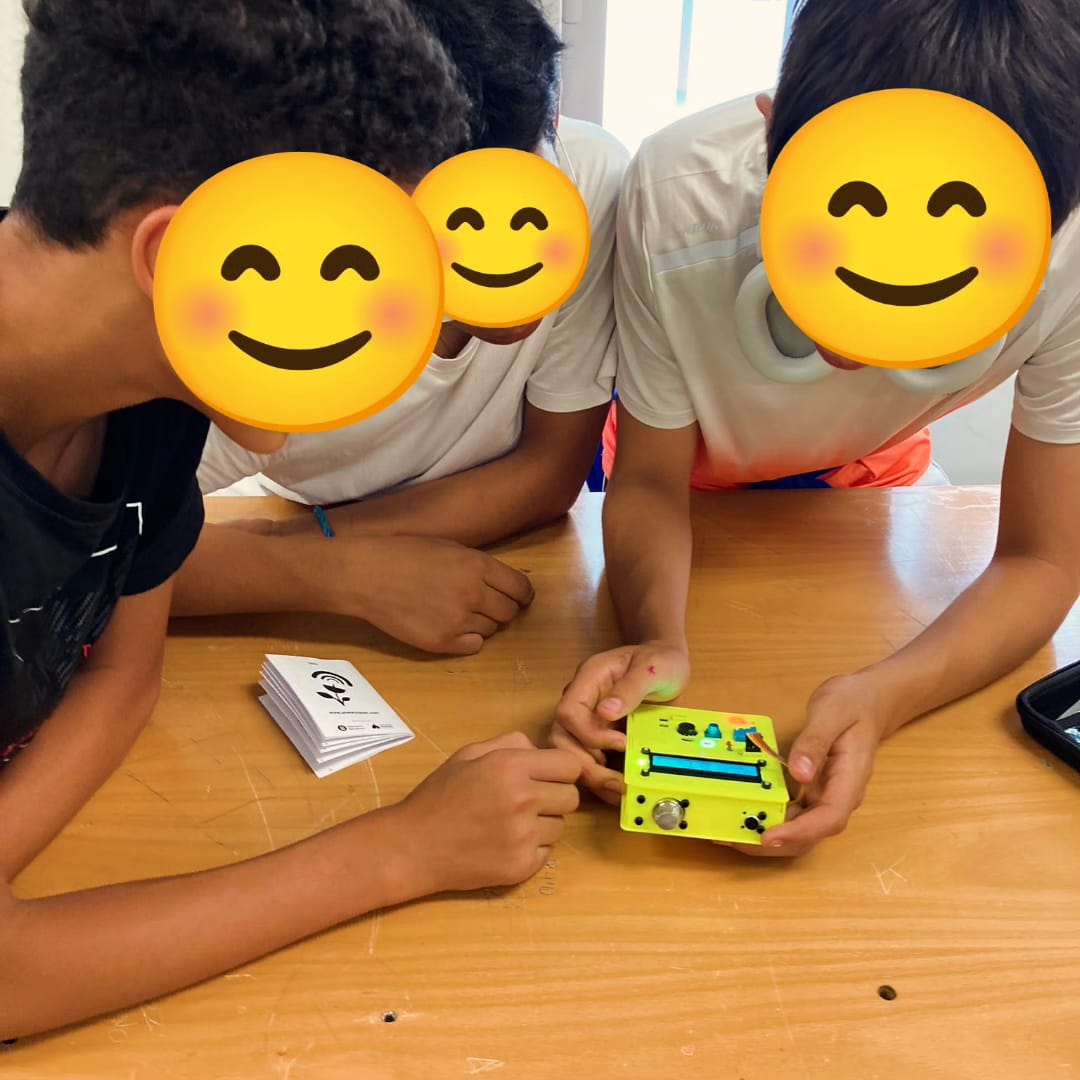
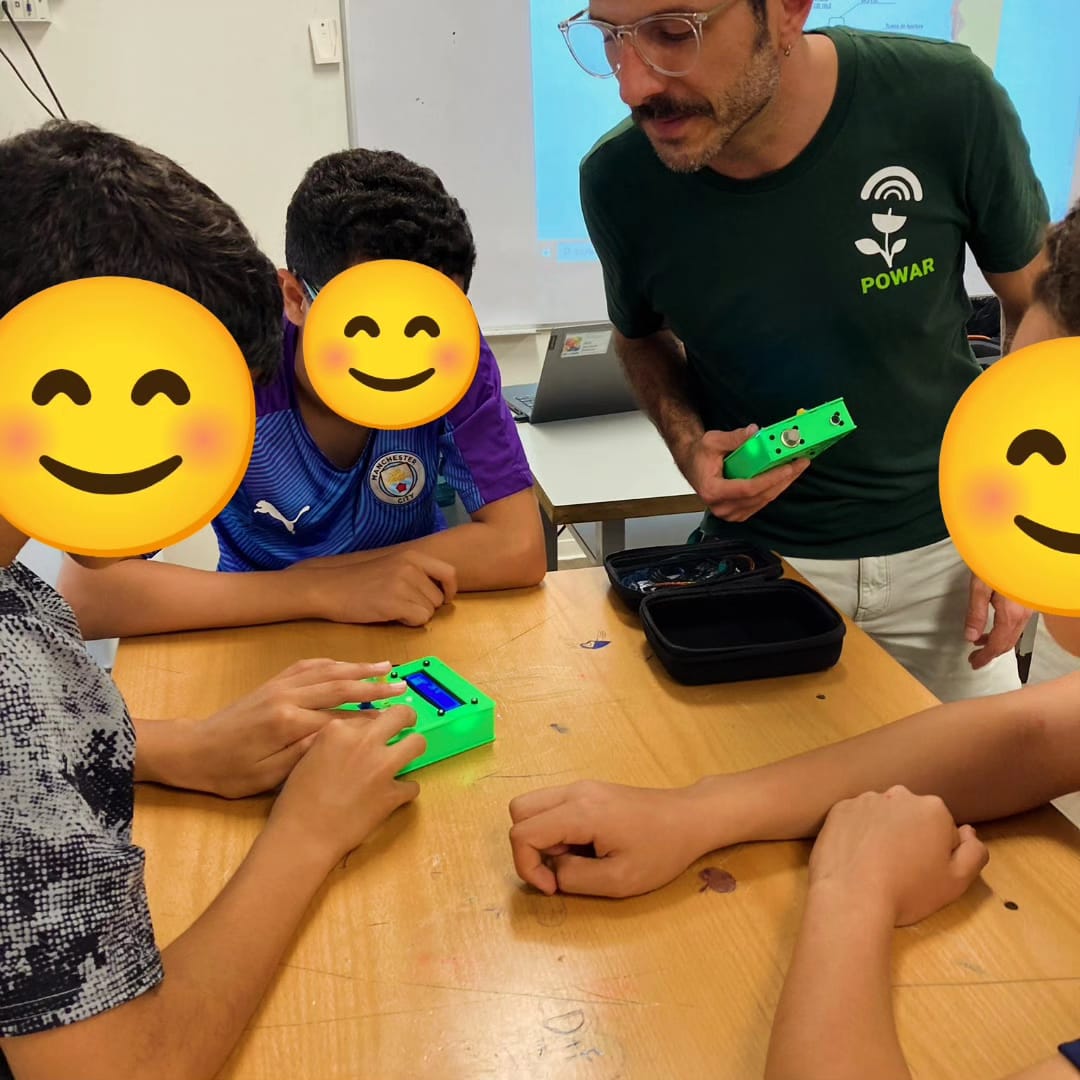
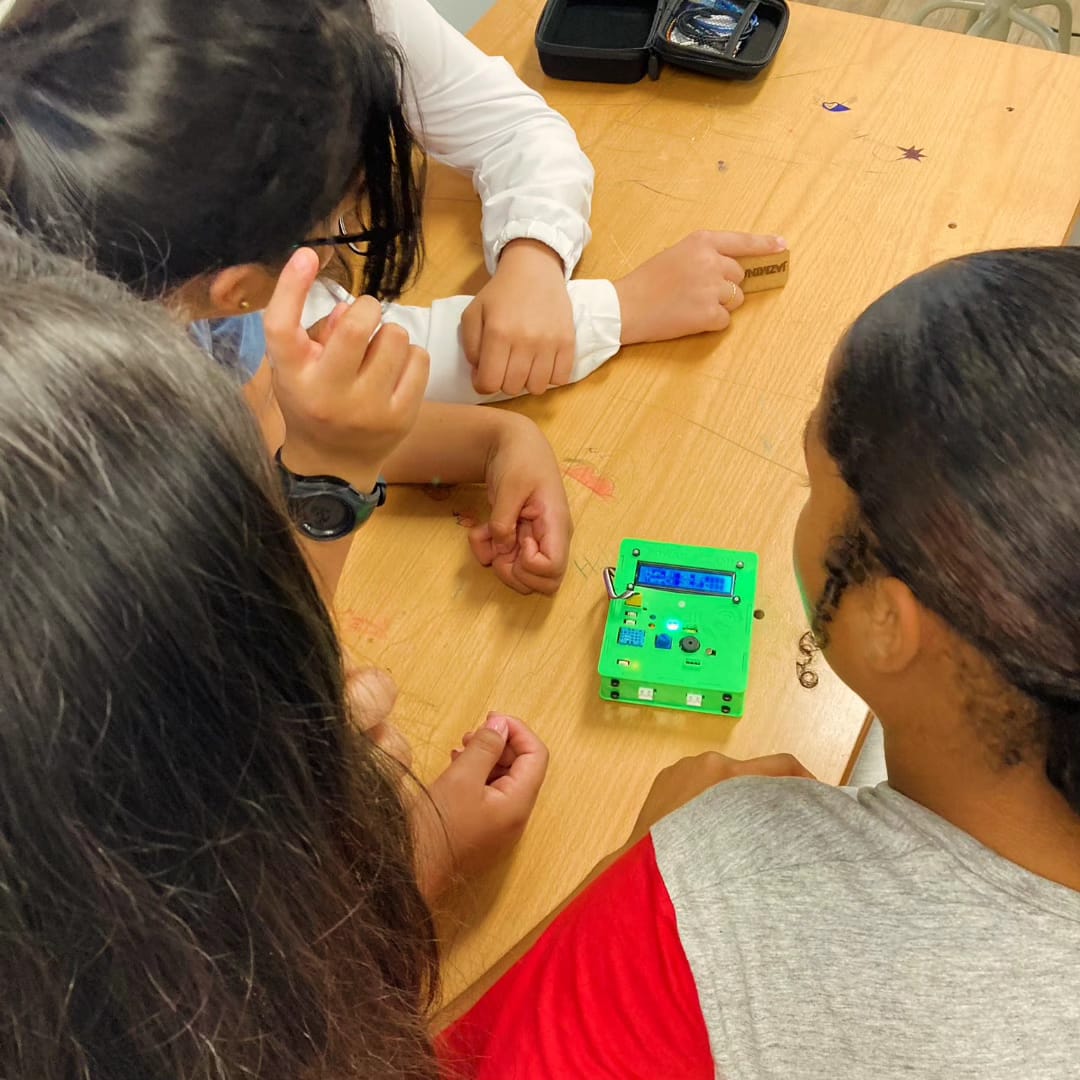
Using the P-Bit for Data Collection
Once familiar with the basic concepts, the students were introduced to the P-Bit. We explained how it works and how the various sensors could be used to measure temperature, humidity, light, and other environmental factors within their school environment.
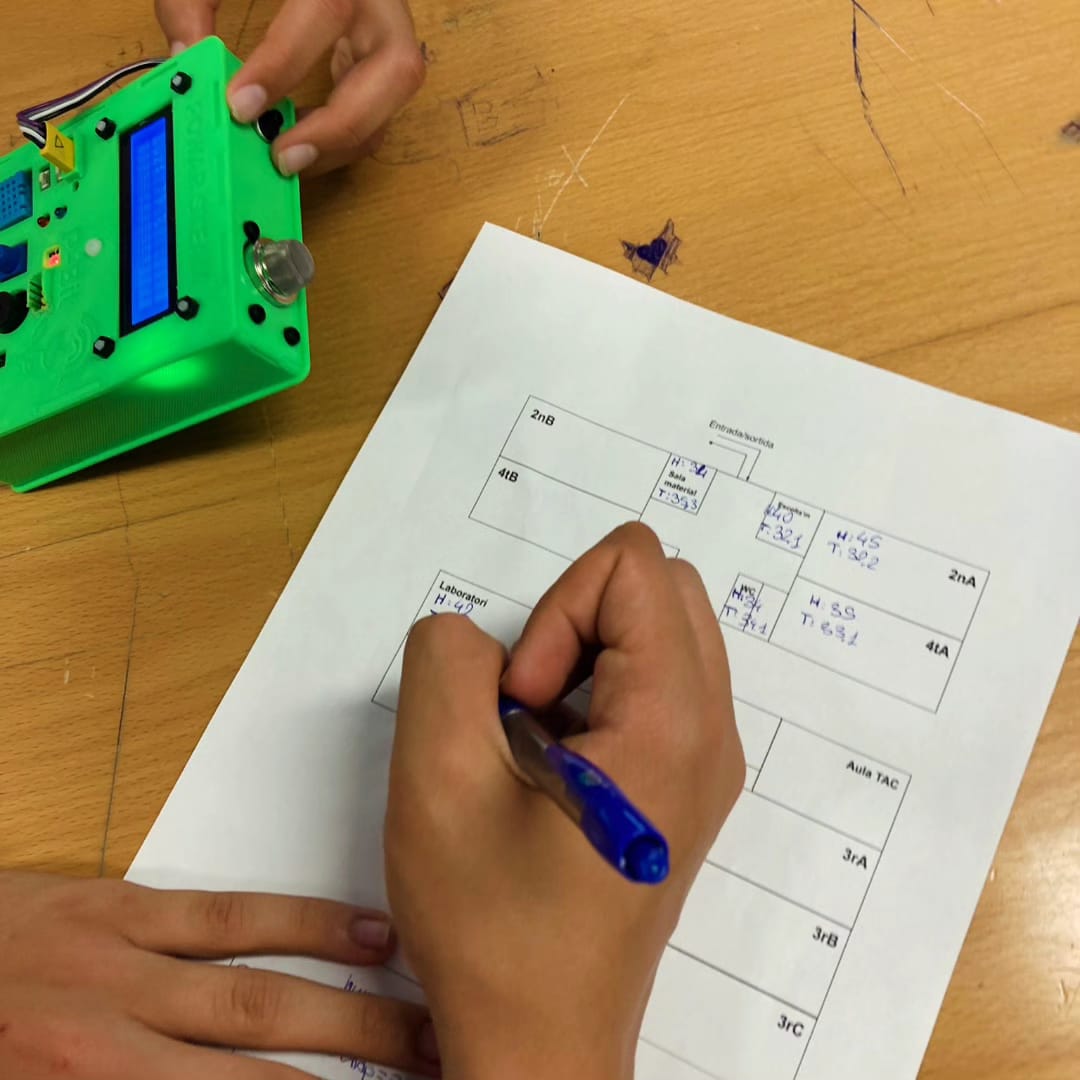
Armed with a simple school map, the students spent 20 minutes exploring different areas, measuring data in classrooms, hallways, and outdoor spaces. They recorded readings on temperature, relative humidity, and light intensity, comparing results between different zones. This hands-on experience allowed them to directly observe environmental variations in their school setting, such as how closed-off areas were more humid, or how crowded spaces tended to be warmer.
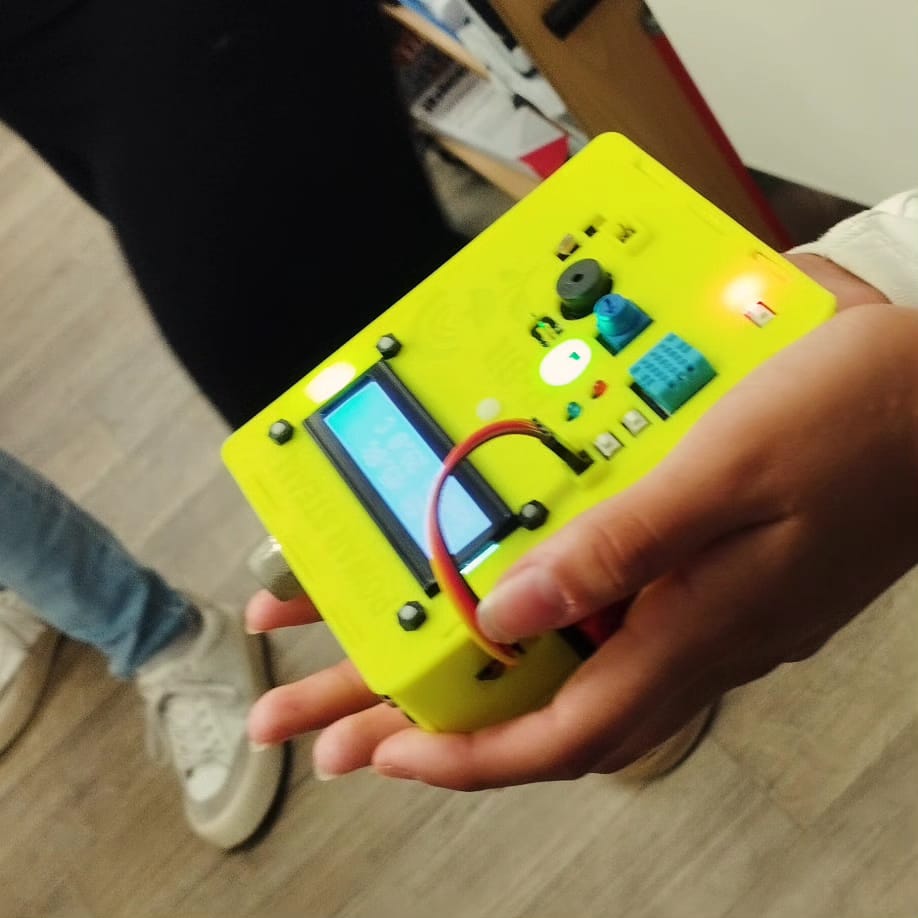
Analyzing the Data and Drawing Conclusions
After collecting the data, we returned to the classroom and collectively analyzed the results. The students quickly identified patterns, such as darker, enclosed spaces had higher humidity levels and warmer areas exposed to sunlight. This exercise not only taught them how to interpret real-time environmental data but also reinforced key concepts about how climate and environmental conditions affect their everyday surroundings.
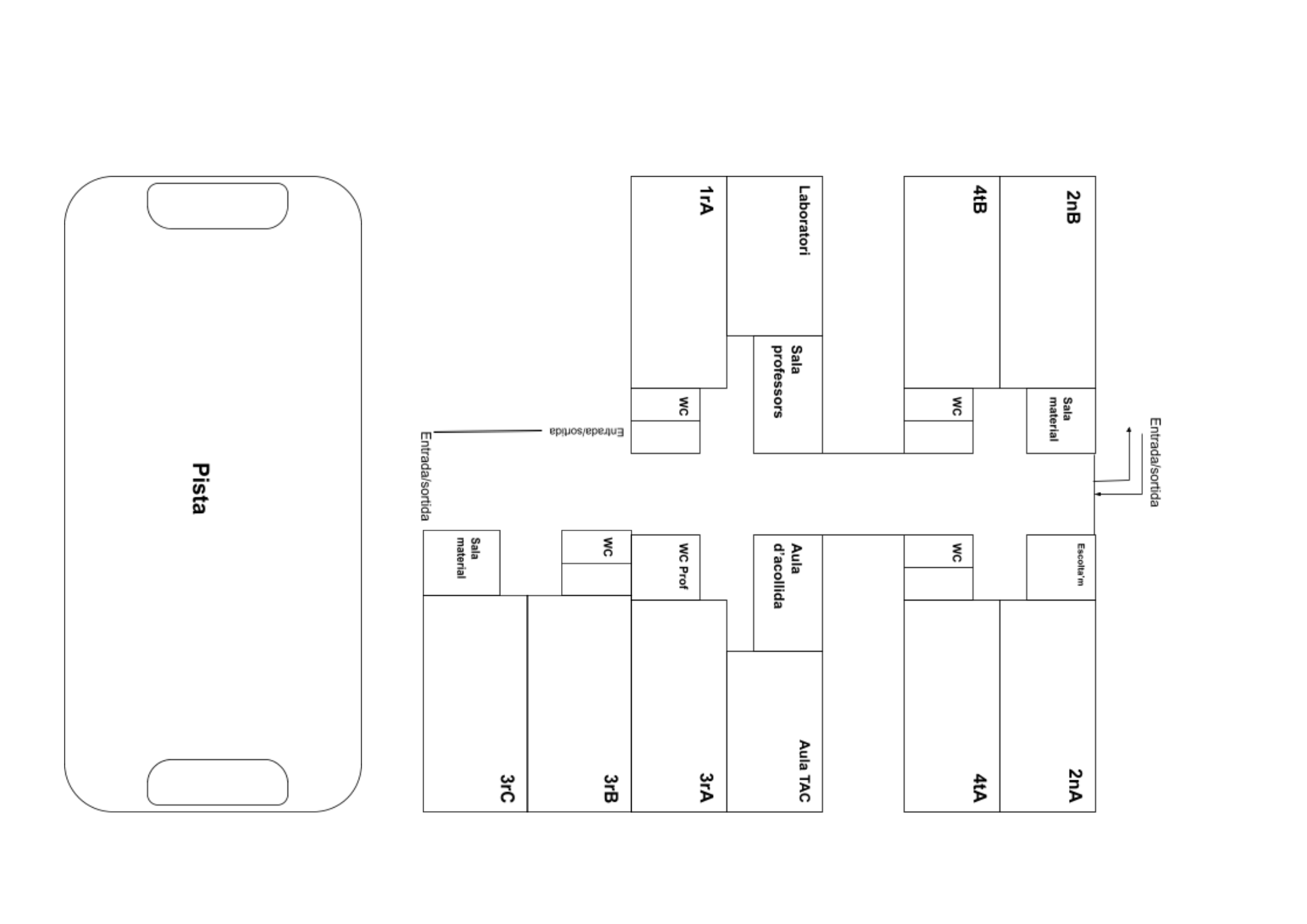
4. New Version Based on Feedback from the Students
Thanks to the valuable feedback we’ve received from both teachers and students, we are already manufacturing a new and improved version of the P-Bit. This version has been redesigned to enhance ease of use and improve the learning experience.
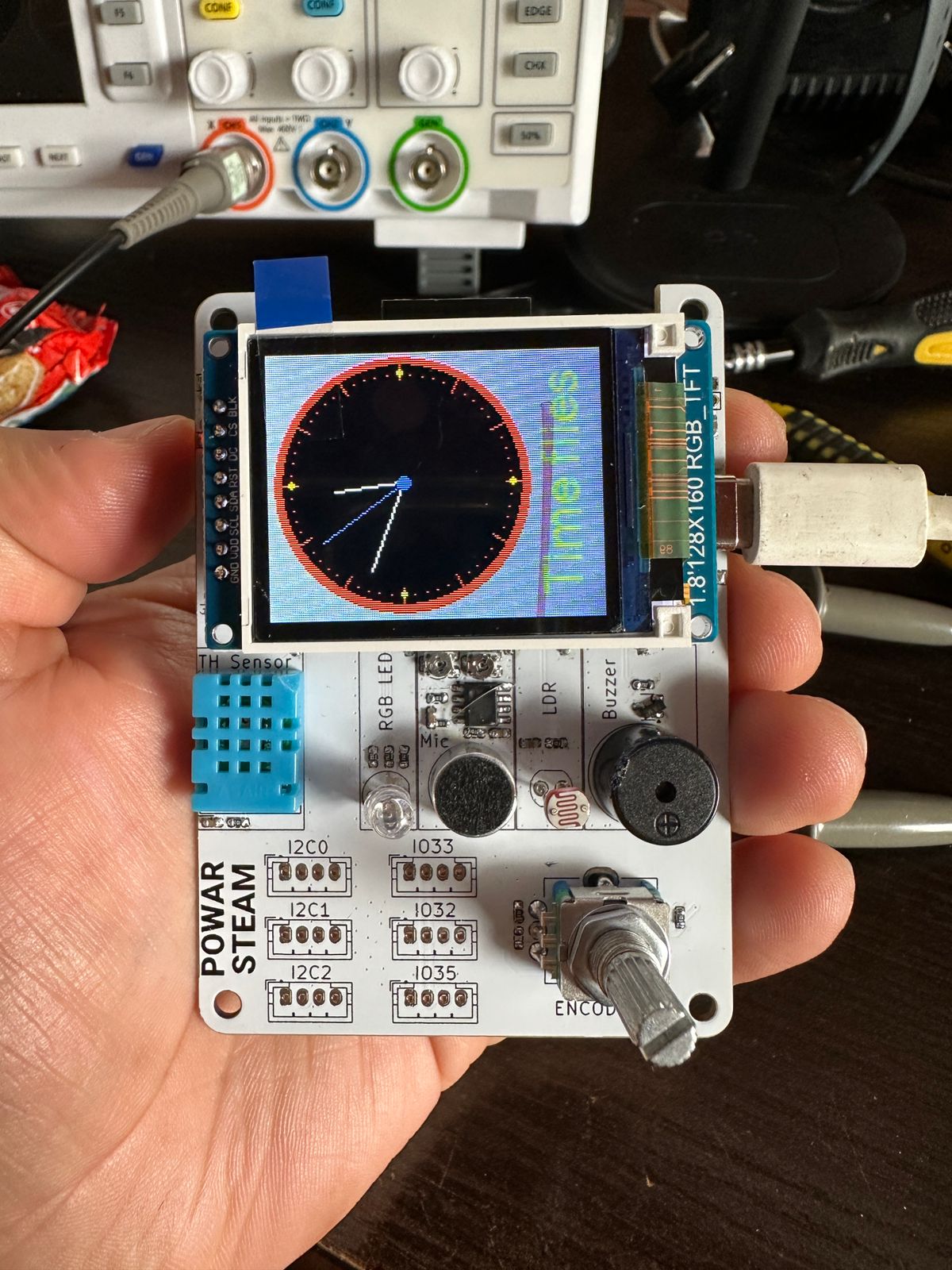
One of the key improvements is the addition of color-coded connectors for each component, making it easier for students to quickly identify where each sensor and wire connects.
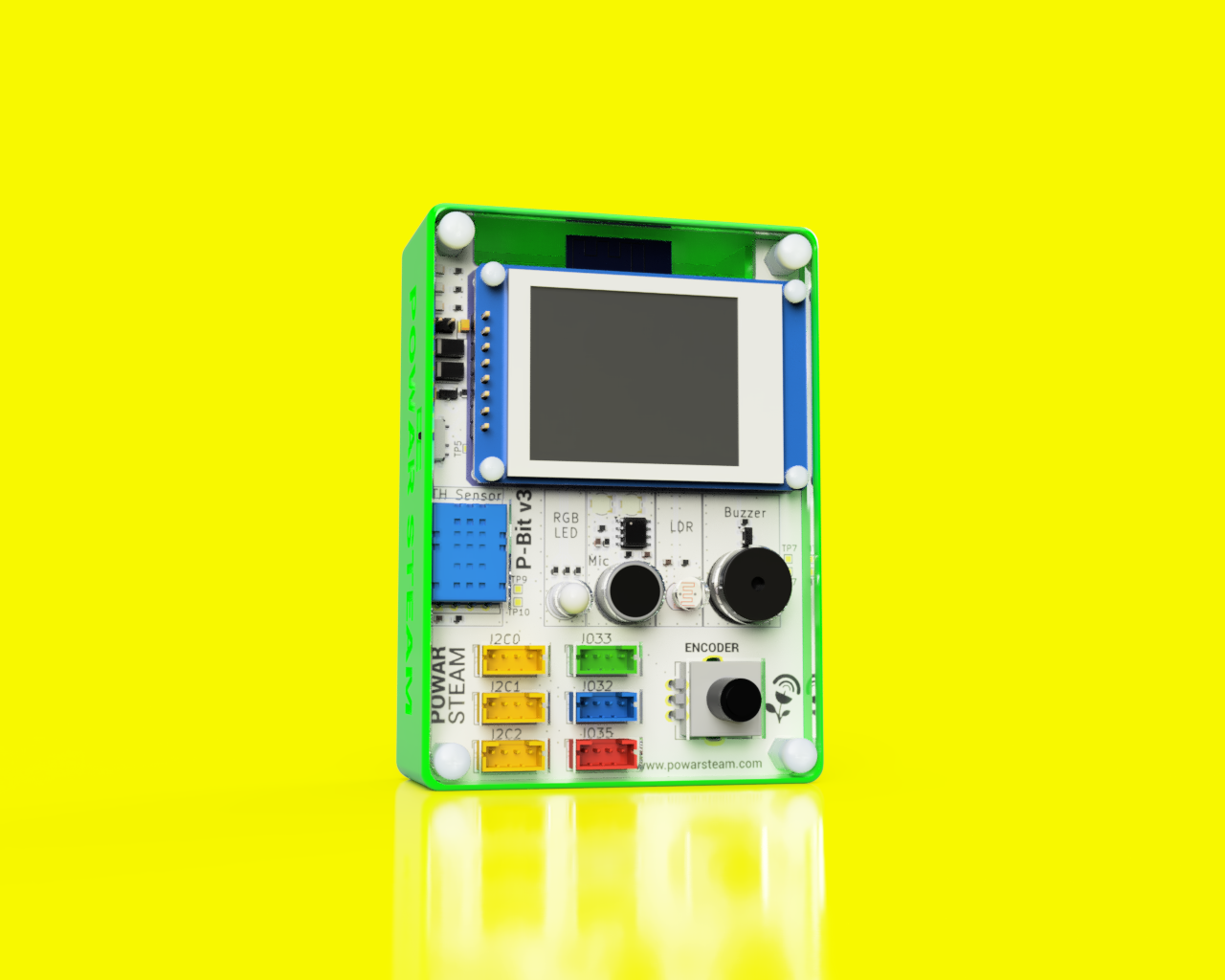
This greatly reduces setup time and minimizes potential confusion, allowing students to focus more on the learning process. Furthermore, all the essential elements are now clearly labeled, helping students better understand the internal workings of the P-Bit without needing extensive prior technical knowledge.
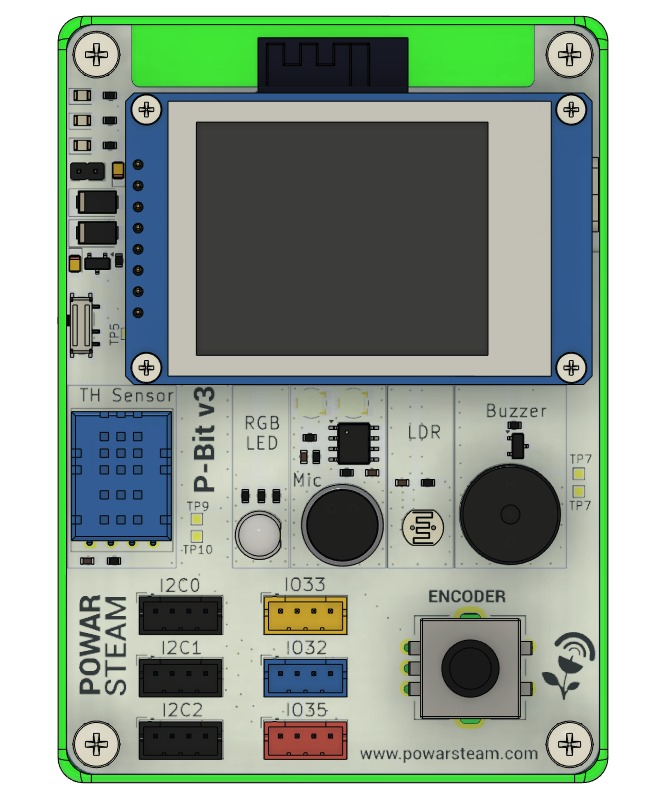
In addition to these enhancements, we’ve made the new P-Bit transparent, allowing students to see the internal circuitry and components. This feature fosters curiosity and deeper interest in engineering and technology as students get a clearer view of how electronic devices work.
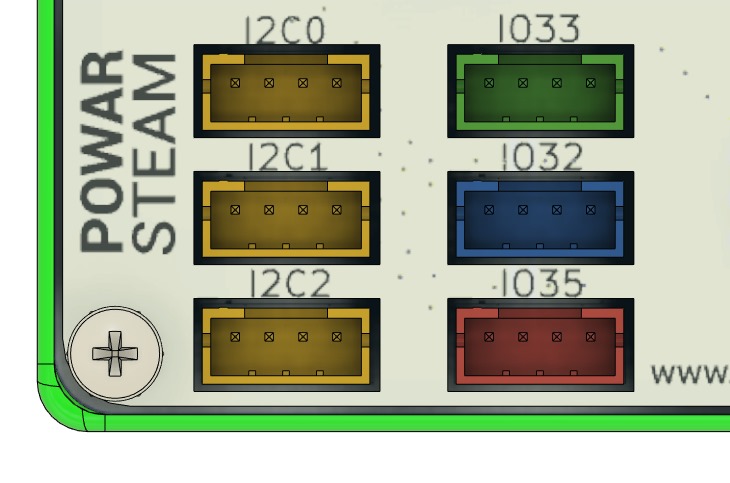
Although the new version is also smaller, making it more portable for classroom use, the real benefit comes from the intuitive design that makes it easier for both teachers and students to engage with the device effectively.
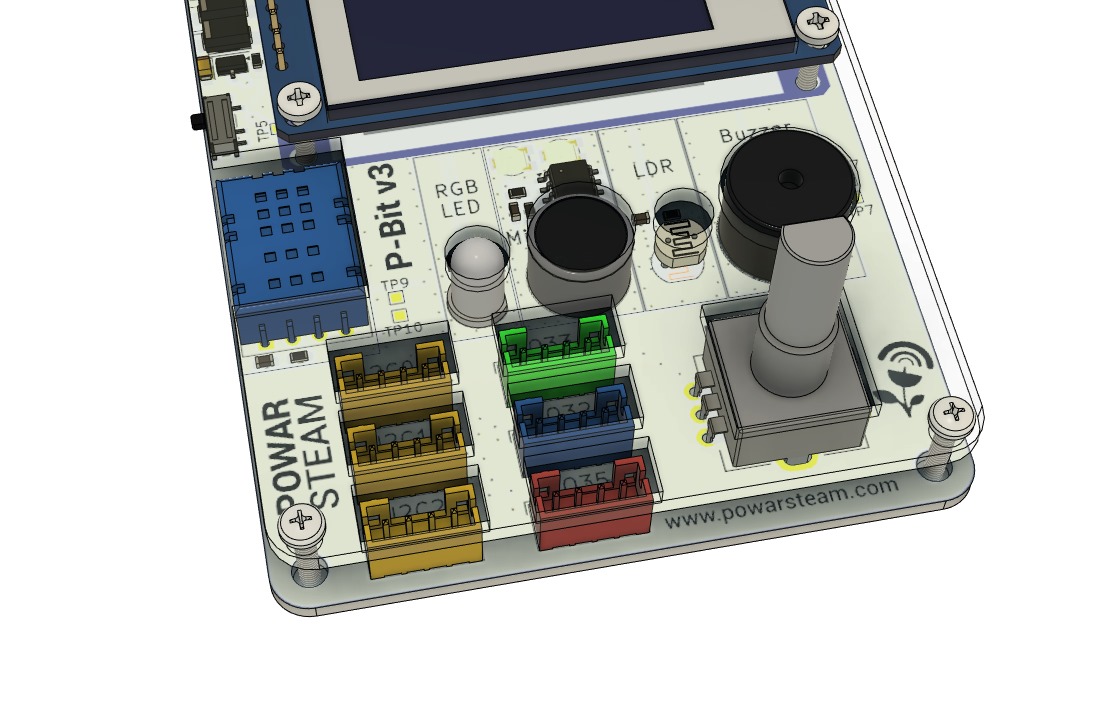
Starting in the 2024-2025 academic year, we will begin testing this new version in schools, where teachers and students will have the opportunity to explore its upgraded features in real-world classroom settings. As always, we will continue gathering feedback during these trials to further refine the design and functionality, ensuring it remains a powerful tool for hands-on learning in sustainability and environmental education.

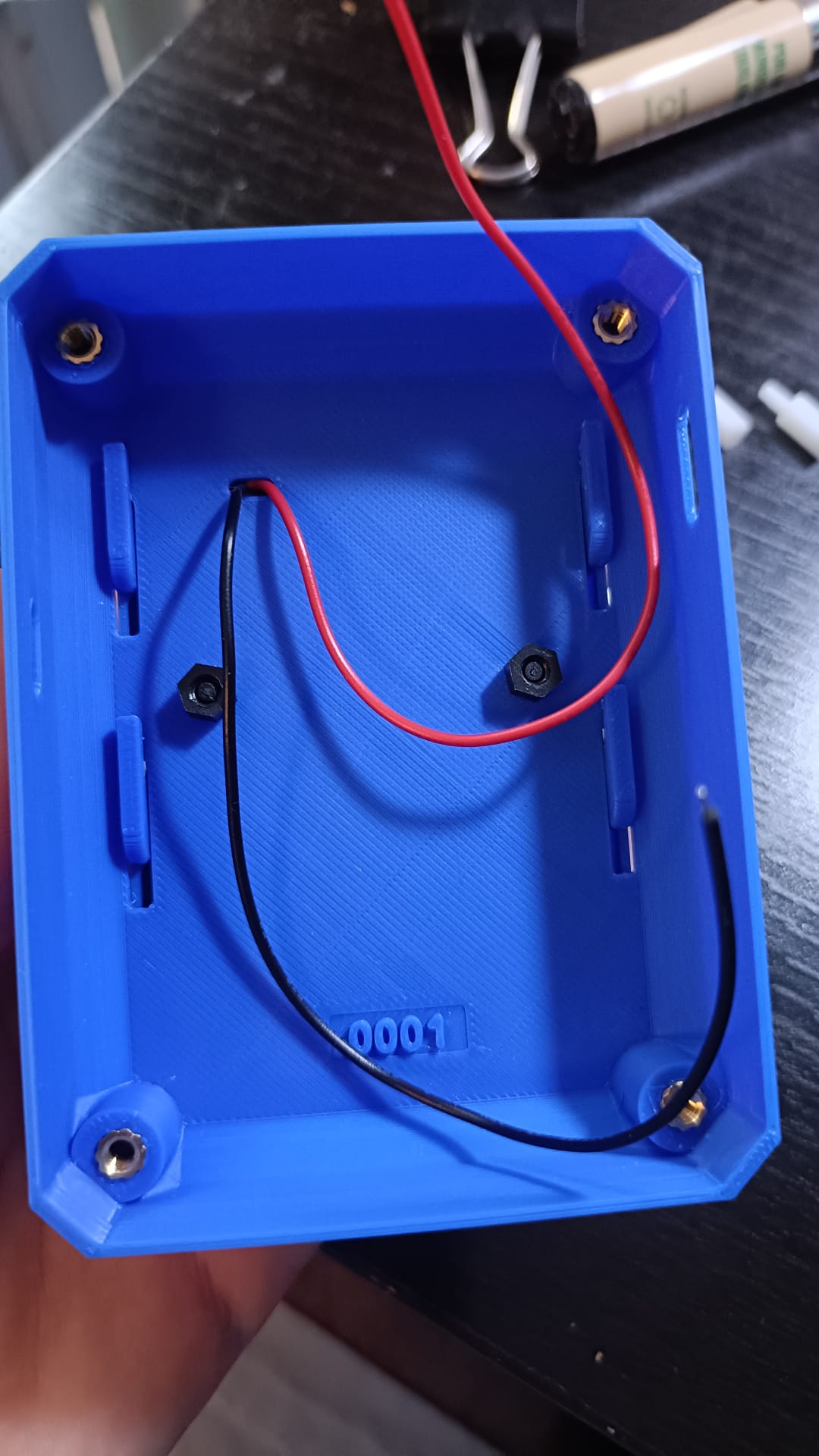
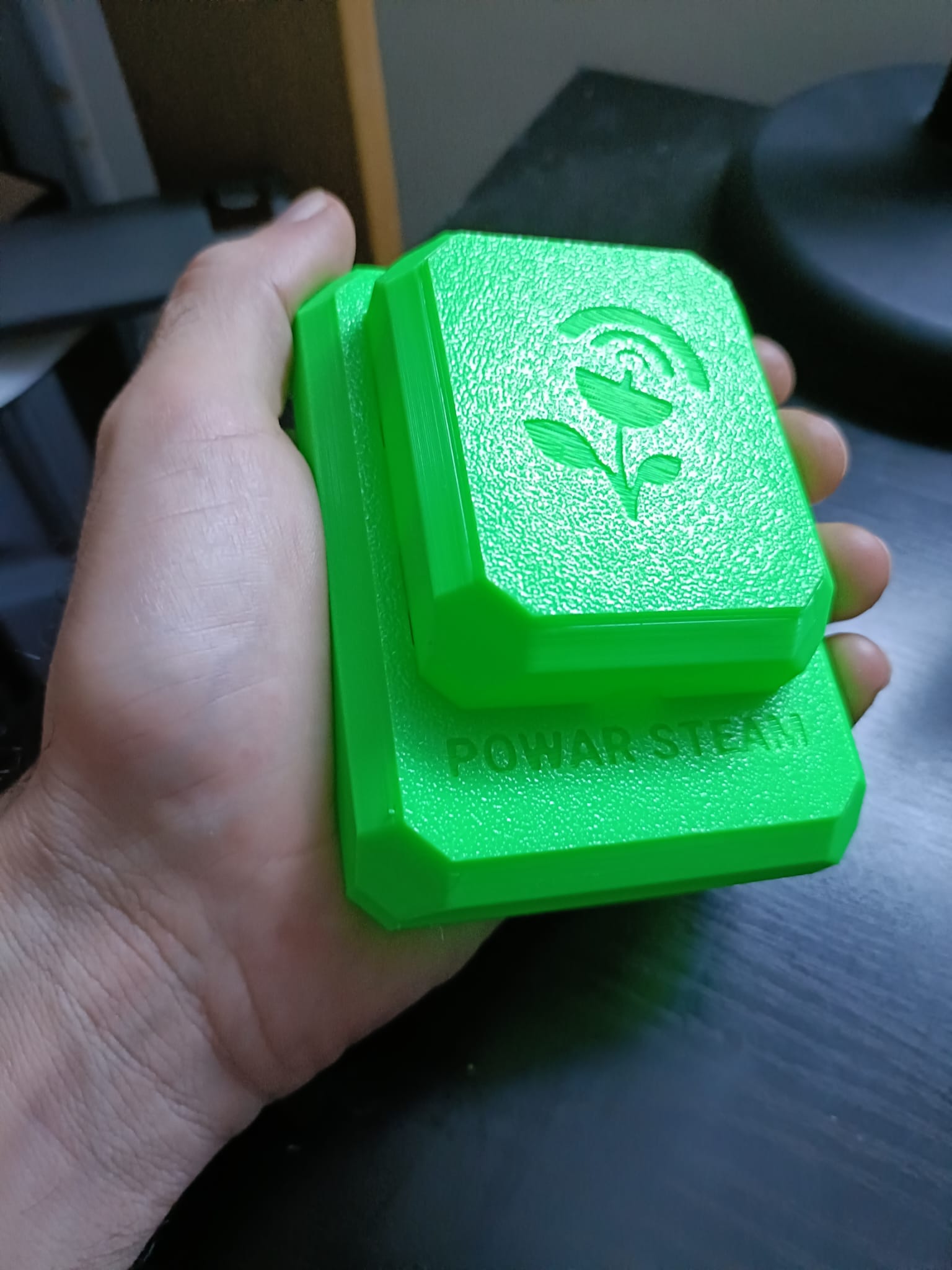
Moreover, the P-Bits are 3D-printed using PLA, a biodegradable material that supports our commitment to sustainability. In the future, schools will be able to 3D print their own P-Bits, customizing them in any color they like or repairing parts that wear out due to classroom use. This approach not only makes the P-Bit more environmentally friendly but also empowers schools to engage in creative problem-solving and sustainability practices.
4. Learning Scenarios for ESO and Primary Education
These learning scenarios incorporate multiple sensors from the P-Bit and are designed to foster inquiry-based learning in environmental science. Each scenario is aligned with LOMLOE competencies and integrates one or more of the GreenComp competencies such as systems thinking, sustainability action, and critical thinking.
1. What is the Relationship Between Temperature, Humidity, and Comfort in Classrooms?
- Sensors: DHT11 (Temperature & Humidity), MQ135 (CO₂)
- Question: How do temperature, humidity, and CO₂ levels impact comfort and concentration in classrooms?
- Activity: Students will use the P-Bit to measure temperature, humidity, and CO₂ levels in different classroom areas during various times of the day. They will compare the data, discussing how these environmental factors affect their comfort and concentration. They will propose strategies for improving comfort, such as adjusting ventilation or rearranging classroom spaces. This scenario develops critical thinking and addresses GreenComp’s "sustainability action" by enabling students to propose actionable solutions.
2. How Can We Measure the Health and Moisture Needs of Our School Garden Plants?
- Sensors: Capacitive Soil Moisture, DHT11 (Temperature & Humidity)
- Question: How can we monitor soil moisture to determine the water needs of our garden plants?
- Activity: Students will collect data on soil moisture and humidity using the P-Bit. By regularly monitoring these variables, they will track changes in plant health and growth. The class will analyze which plants thrive in different areas based on environmental conditions and propose an irrigation plan that optimizes water usage. This scenario addresses GreenComp’s "systems thinking" by encouraging students to understand the relationship between plant health and environmental conditions.
3. How Do City Building Materials Affect Urban Climate?
- Sensors: DHT11 (Temperature & Humidity), LDR (Light), MQ135 (Air Quality)
- Question: How do different materials used in urban environments affect temperature and air quality?
- Activity: Students will measure temperature, light intensity, and air quality in various locations around the school (e.g., near concrete, grass, or trees). They will analyze the data to observe the urban heat island effect and air pollution levels, comparing the impact of green spaces versus concrete-heavy areas. This scenario encourages systems thinking and the development of sustainable city planning ideas, as students propose solutions like increasing green spaces.
4. How Can We Reduce CO₂ Levels in the Classroom?
- Sensors: MQ135 (CO₂ & Air Quality), DHT11 (Temperature & Humidity)
- Question: What actions can we take to reduce CO₂ levels in indoor spaces like classrooms?
- Activity: Students will use the P-Bit to monitor CO₂ levels in classrooms throughout the school day, comparing CO₂ concentrations before and after different ventilation methods (e.g., opening windows, using air purifiers). They will analyze how CO₂ levels fluctuate based on the number of people in the room and propose strategies for improving air quality. This scenario promotes sustainability action and empowers students to take responsibility for their environment.
5. How Does Light Influence the Growth of Plants?
- Sensors: LDR (Light), DHT11 (Temperature)
- Question: How does light intensity affect plant growth and development?
- Activity: Students will place plants in different locations with varying light exposure, using the P-Bit to measure light intensity and temperature. Over time, they will track plant growth and observe how the amount of light impacts photosynthesis and overall plant health. This scenario encourages students to understand the role of natural cycles in plant biology and connects to critical thinking about environmental factors affecting plant life.
6. How Can We Scientifically Determine the Best Watering Schedule for Our Garden?
- Sensors: Capacitive Soil Moisture, DHT11 (Temperature & Humidity)
- Question: How can we use data to create the optimal watering schedule for plants in the garden?
- Activity: Using the P-Bit, students will regularly measure soil moisture levels and environmental conditions in different parts of the garden. By analyzing this data, they will develop a scientific approach to watering, ensuring plants receive the right amount of water without waste. This scenario connects to resource management and promotes sustainability action by teaching students to conserve water.
7. Investigating Air Quality Inside and Outside the School
- Sensors: MQ135 (Air Quality), DHT11 (Temperature & Humidity)
- Question: How does air quality differ between indoor and outdoor environments, and what factors contribute to these differences?
- Activity: Students will measure air quality inside classrooms and compare it to outdoor spaces around the school. They will investigate how different factors (e.g., ventilation, and outdoor traffic) affect air quality. After analyzing the data, students will propose ways to improve air quality indoors, such as through better ventilation or green spaces. This scenario develops systems thinking and empowers students to understand and act on environmental health issues.
8. How Do Different Classroom Activities Impact Noise Levels?
- Sensors: MAX4466 (Sound), MQ135 (CO₂)
- Question: How do different classroom activities affect noise levels, and what impact does this have on learning?
- Activity: Students will measure sound levels during various classroom activities (e.g., lectures, group work, quiet reading) and analyze how noise impacts their ability to concentrate. They will also measure CO₂ levels to see if there's a relationship between noise and air quality in crowded spaces. This scenario promotes critical thinking and teaches students about acoustic pollution and its effects on the learning environment.
9. How Can We Predict Weather Patterns by Measuring Environmental Changes?
- Sensors: DHT11 (Temperature & Humidity), LDR (Light)
- Question: Can environmental data collected daily help predict weather changes?
- Activity: Students will collect data on temperature, humidity, and light intensity at the same time each day, tracking changes over a week. They will compare their findings to weather reports, learning how meteorologists use similar data to predict short-term weather patterns. This scenario develops systems thinking and helps students understand the connection between environmental variables and climate.
10. How Do Seasonal Changes Affect the Health of School Plants?
- Sensors: Capacitive Soil Moisture, LDR (Light), DHT11 (Temperature & Humidity)
- Question: How do different seasons impact plant health and growth in the school garden?
- Activity: Students will use the P-Bit to measure soil moisture, light intensity, and temperature over several weeks, tracking how these variables change with the seasons. They will observe the effects on plant growth and propose ways to support plants in different seasons, such as mulching or adjusting watering schedules. This scenario helps students understand the ecosystem dynamics related to plant life.
11. Can We Reduce Energy Use by Understanding Classroom Lighting?
- Sensors: LDR (Light), DHT11 (Temperature)
- Question: How can optimizing classroom lighting reduce energy consumption?
- Activity: Students will measure the light intensity in different parts of the classroom and analyze how much artificial lighting is being used. They will explore how adjusting window coverings or seating arrangements could reduce the need for artificial light, thus conserving energy. This scenario encourages critical thinking and promotes energy-saving practices aligned with sustainability action.
12. How Does CO₂ Accumulate in Crowded Spaces?
- Sensors: MQ135 (CO₂), DHT11 (Temperature & Humidity)
- Question: How does CO₂ build up in spaces with high occupancy, and how can we manage it?
- Activity: Students will measure CO₂ levels in various crowded areas such as classrooms, hallways, and assembly rooms. They will analyze how ventilation affects CO₂ buildup and propose strategies to improve air quality in these spaces, such as better airflow management. This scenario supports GreenComp’s "empowerment for sustainability" by promoting actionable solutions.
13. How Does Noise Pollution Differ Around the School?
- Sensors: MAX4466 (Sound)
- Question: How does noise pollution vary in different parts of the school, and how does it affect students’ well-being?
- Activity: Students will take sound level measurements in various locations such as hallways, classrooms, and outdoor areas. They will analyze the data to determine which areas experience the most noise pollution and propose solutions to minimize its impact on students' well-being. This scenario promotes critical thinking about environmental noise and its effects on health.
14. How Can We Monitor Plant Health and Predict Growth Patterns?
- Sensors: Capacitive Soil Moisture, LDR (Light), DHT11 (Temperature)
- Question: How can we track plant health by monitoring environmental conditions over time?
- Activity: Students will monitor plant health in the school garden, tracking soil moisture, light intensity, and temperature at regular intervals. They will use this data to predict growth patterns and propose strategies for improving plant care, such as adjusting watering schedules or optimizing sunlight exposure. This scenario fosters systems thinking and teaches students about the relationship between environment and plant biology.
15. How Do Outdoor and Indoor Humidity Levels Compare, and What Does It Mean for Air Quality?
- Sensors: DHT11 (Humidity & Temperature), MQ135 (Air Quality)
- Question: How do humidity levels differ between outdoor and indoor spaces, and what impact does this have on air quality?
- Activity: Students will compare humidity and air quality levels indoors and outdoors using the P-Bit. They will analyze how different building structures and environmental factors affect air quality and propose ways to manage humidity levels in indoor spaces. This scenario helps students understand the impact of built environments on health and well-being, fostering critical thinking and sustainability action.
5. Collaborative Projects with Foodshift Pathways
Starting in the 2024-2025 school year, we will collaborate with the Foodshift Pathways European program to implement a series of innovative learning scenarios designed to promote sustainability education. These projects will leverage the P-Bit to engage students in activities focused on resource management, waste reduction, and environmental impact. Each scenario will use the P-Bit’s sensors to collect and analyze environmental data, encouraging students to think critically and adopt a data-driven approach to understanding sustainability.
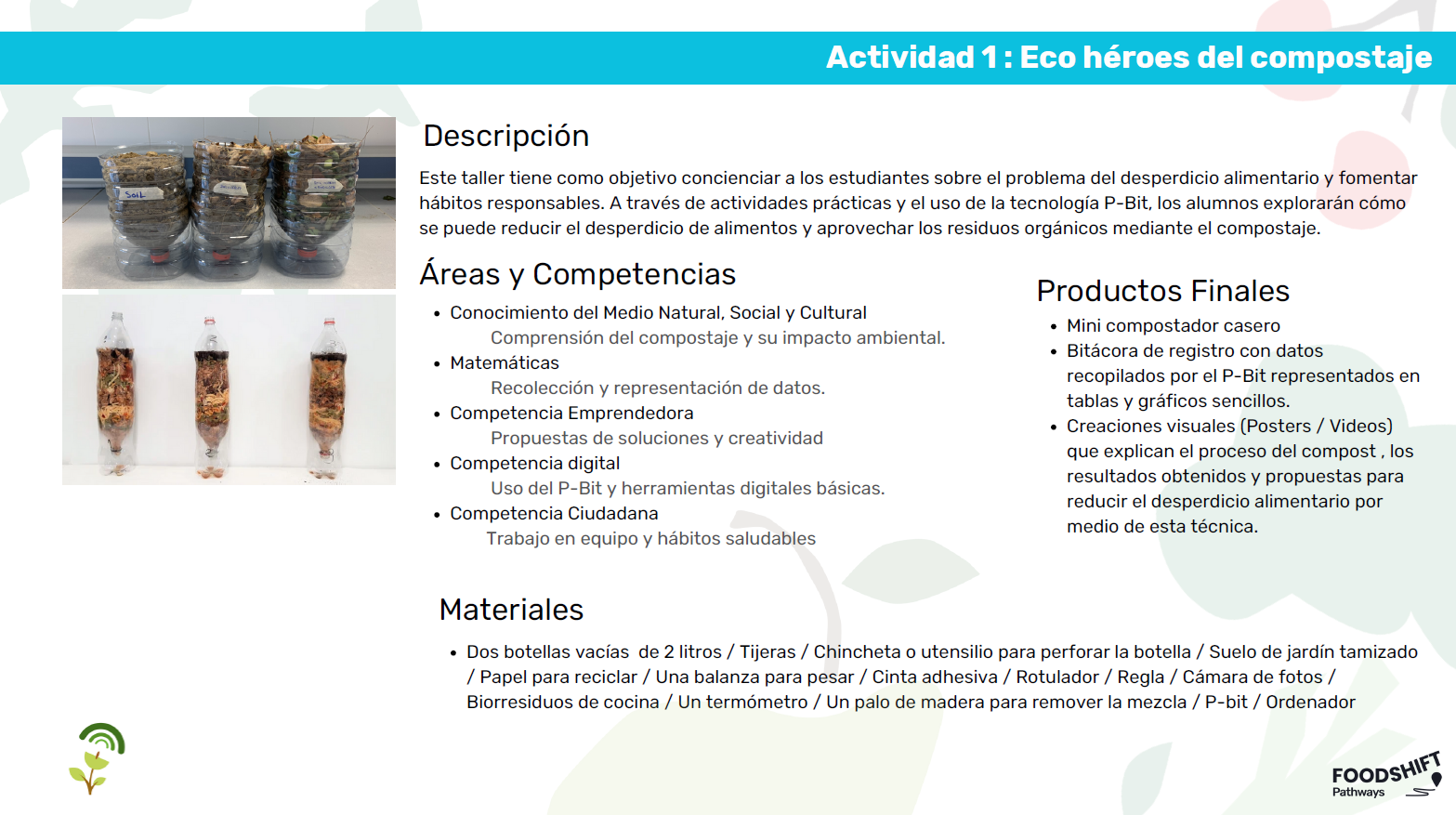
1. Eco Heroes of Composting
In this scenario, students will explore food waste reduction through composting. Using the P-Bit’s temperature and humidity sensors, they will track the decomposition process in homemade composters. They will analyze moisture levels and temperature to determine optimal conditions for composting and present their findings through digital logs and visual presentations that propose solutions to reduce food waste.
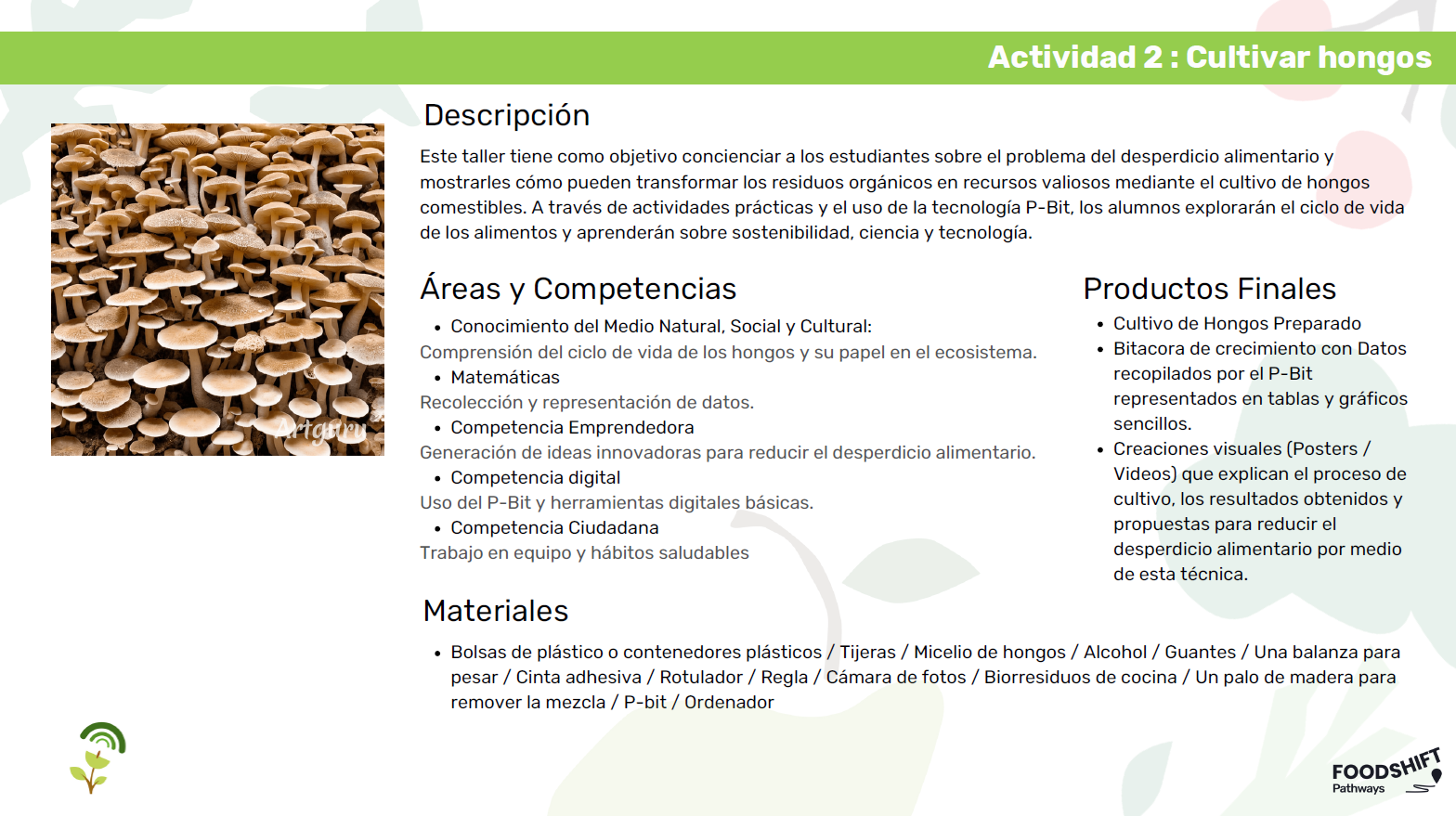
2. Growing Mushrooms
Students will use organic waste to grow edible mushrooms while monitoring humidity and temperature with the P-Bit. They will track the mushroom life cycle, record data, and analyze how environmental factors affect growth. This project will conclude with the creation of a mushroom cultivation system and student reports highlighting the role of fungi in reducing waste and promoting ecosystem health.
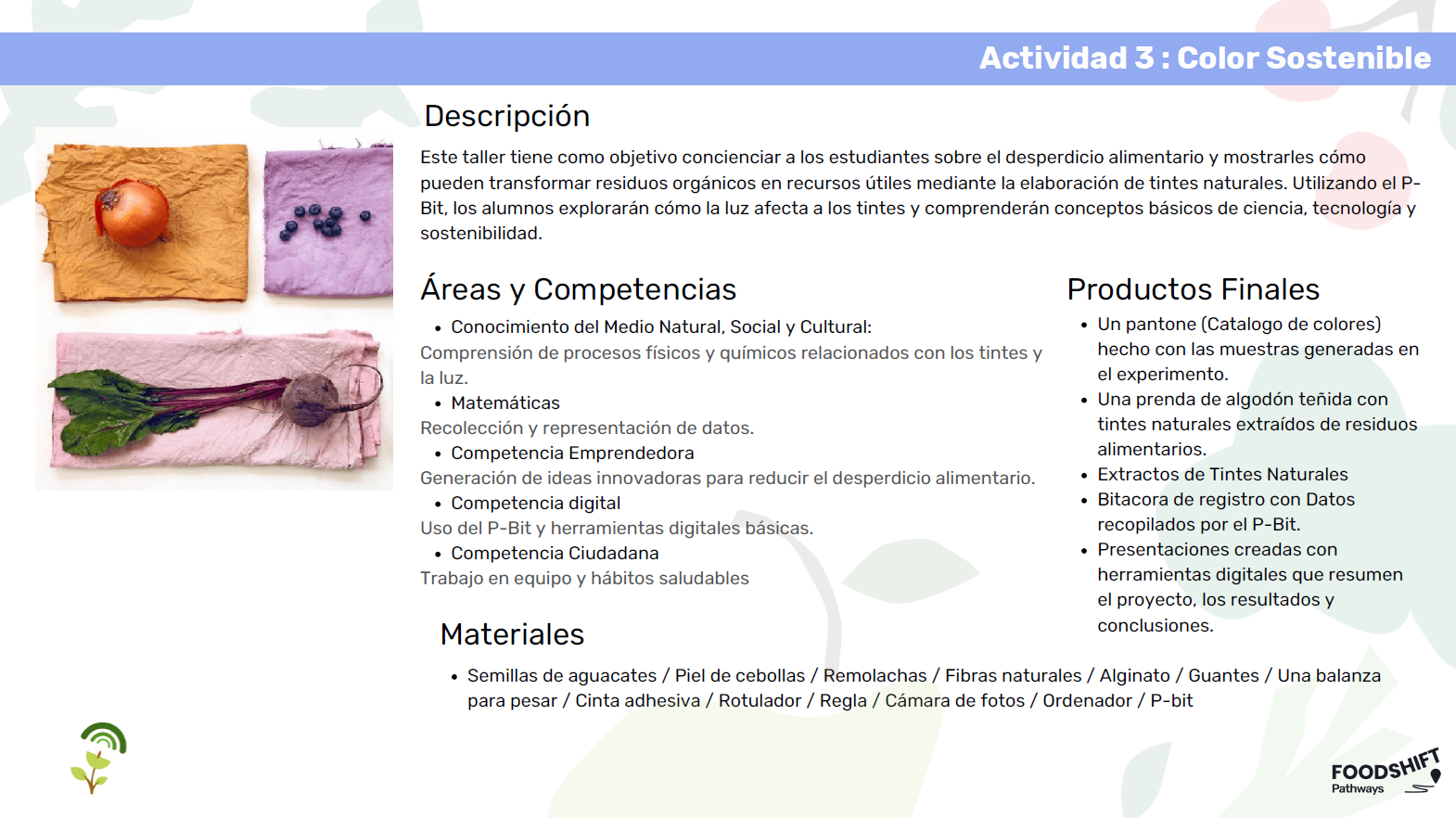
3. Sustainable Dyeing
In this activity, students will learn how to create natural dyes from organic waste like onion peels and beets. The light sensor on the P-Bit will help track the impact of light exposure on the dyeing process. Students will produce textile samples, create a colour catalogue, and present their results, making connections between fashion and environmental sustainability.

4. From Waste to Resource: Homemade Vinegar Fermentation
Students will use food scraps to make vinegar through natural fermentation. The P-Bit will monitor temperature and light to help students understand how these factors influence fermentation. They will document the process in detailed logs, accompanied by recipes aimed at reducing food waste. This project teaches students about food sovereignty and how to transform waste into valuable resources.
Join Us in Transforming Education with the P-Bit
We invite schools across Catalunya, Spain, Europe, and beyond to participate in testing or purchasing the P-Bit for your classrooms. We are currently working with educators to develop new learning scenarios focused on sustainability, using the P-Bit to make complex environmental concepts easier to understand in a fun and engaging way.
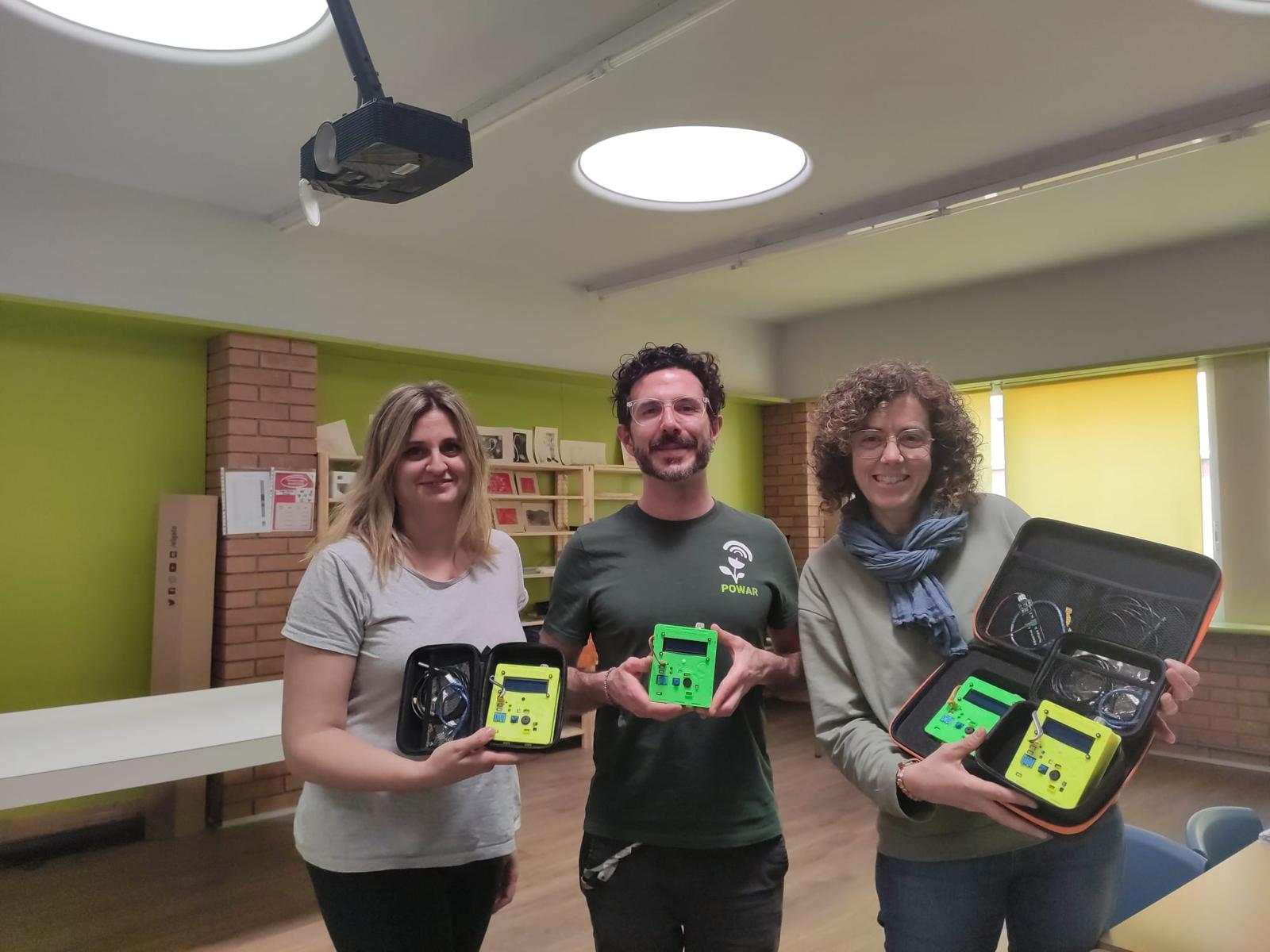
Our mission is to provide teachers with a tool that simplifies the teaching of STEAM and environmental education, allowing students to actively explore real-world data. If you’re interested in bringing the P-Bit to your school, reach out to us at:
- Website: www.powarsteam.com
-
Email: info@powarsteam.com or pablo@powarsteam.com
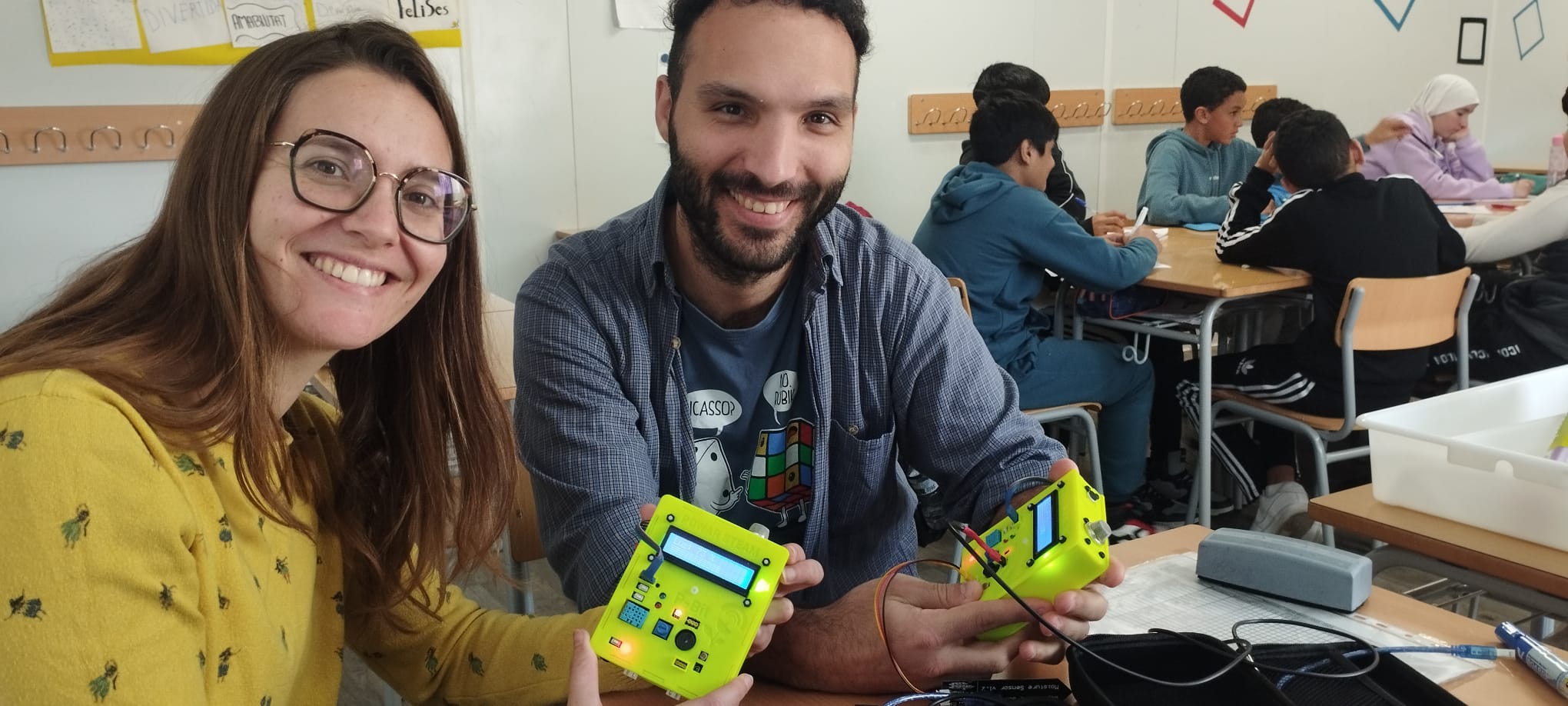
We would also like to extend our deepest thanks to the Pere Lliscart and Pau Sants schools in Hospitalet, Spain, as well as to all the teachers who have supported us in this endeavour and those who are joining us in this journey.

Together, we can equip the next generation with the skills and knowledge they need to tackle the challenges of tomorrow.
Pablo Zuloaga Betancourt
CEO / Co-Founder of POWAR STEAM


Please log in or sign up to comment.